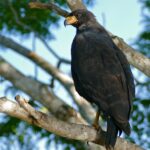Great Black Hawks (Buteogallus urubitinga) are a species of large raptor found in Central and South America. These majestic birds are known for their impressive courtship displays and mating behaviors. In this blog post, we’ll explore the fascinating details of how Great Black Hawks mate.
Courtship Displays and Pair Bonding
The mating process for Great Black Hawks begins with elaborate courtship displays. During the breeding season, which typically runs from late February to late May, male and female hawks engage in a series of aerial maneuvers to strengthen their pair bond and establish a territory.
The male Great Black Hawk will often initiate the courtship by performing slow, deep-flapping flights, soaring high, and then diving and hanging in the air. The female may join the male in these displays, flying in tandem, calling, dangling her legs, and even flying upside down to lock or touch talons with her mate.
Both male and female Great Black Hawks also make swooping passes at their perched partner as part of the courtship ritual. These displays serve to reinforce the pair’s bond and signal their readiness to mate.
Nest Building and Egg Laying
 Image source: Great Black Hawk by Bernard DUPONT
Image source: Great Black Hawk by Bernard DUPONT
Once the pair has established their territory and strengthened their bond, the female Great Black Hawk will begin building the nest. These birds typically construct platform nests made of sticks, often in emergent trees or on power poles, usually 5-30 meters above the ground.
The nests are often reused and can grow larger over time as the pair adds more materials to it. The female lays one to three whitish eggs with brown markings, and both parents share the incubation duties, with the female taking the lead in brooding the young under her wings while the male brings food to the nest.
Incubation and Chick Rearing
The eggs of Great Black Hawks must be incubated for 35-37 days before they hatch. During this time, the parents take turns sitting on the nest, with the female doing the majority of the brooding.
After the chicks hatch, the male Great Black Hawk becomes the primary provider, bringing food to the nest for the female and the offspring. The young hawks grow quickly and remain with their parents for several months after fledging, learning how to hunt and survive on their own.
Conservation Status
Great Black Hawks are currently classified as a species of least concern by the IUCN Red List, with a global breeding population of approximately 2 million individuals. However, they face threats from habitat loss and shooting in some areas, and their populations are decreasing.
Conclusion
The mating process of Great Black Hawks is a fascinating display of avian behavior. From the elaborate courtship displays to the cooperative nest building and chick rearing, these birds demonstrate a remarkable level of adaptability and resilience. By understanding the intricacies of their mating habits, we can better appreciate the unique ecology and conservation needs of this impressive raptor species.


